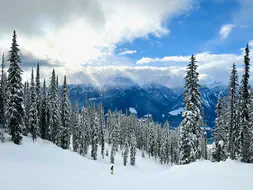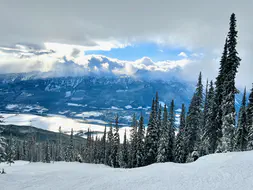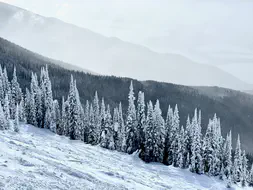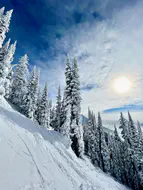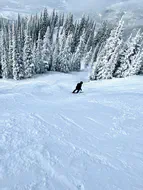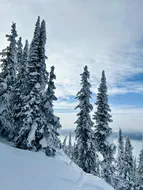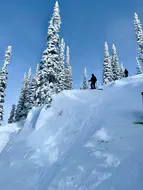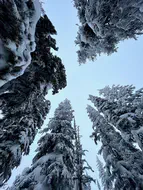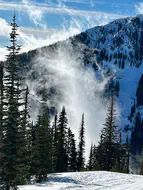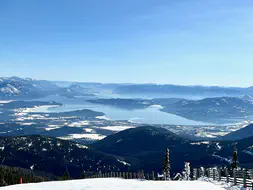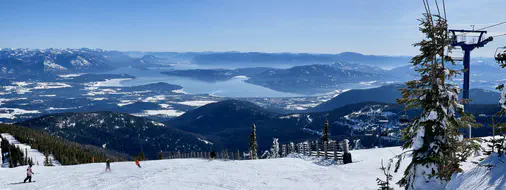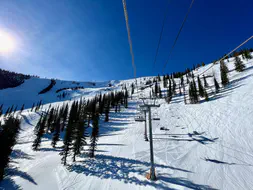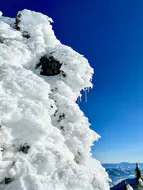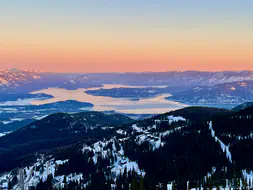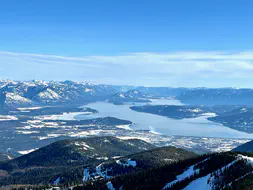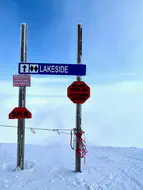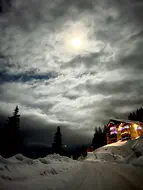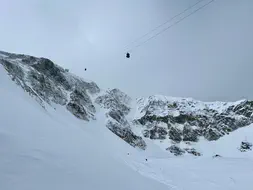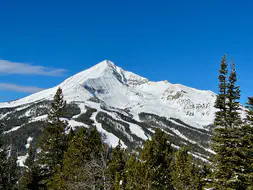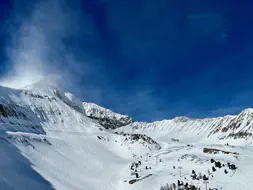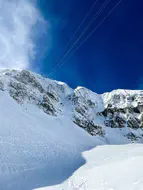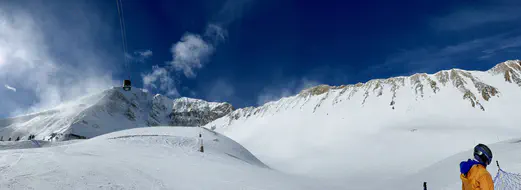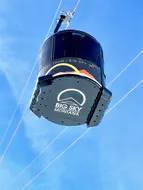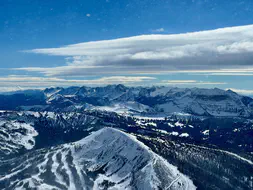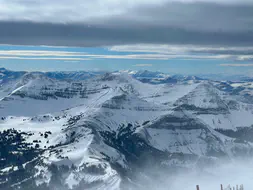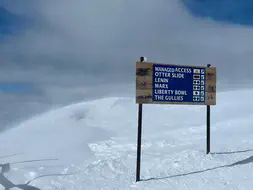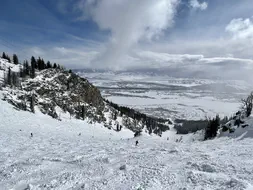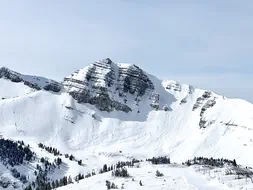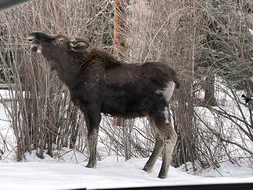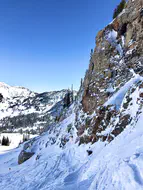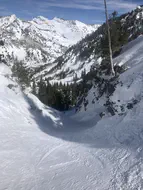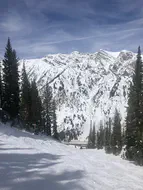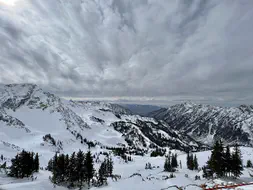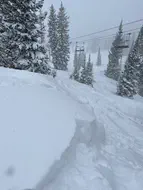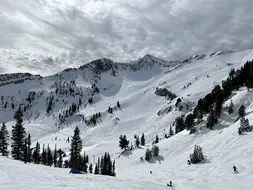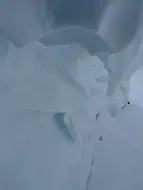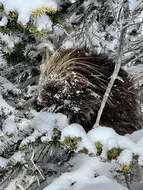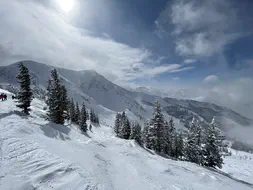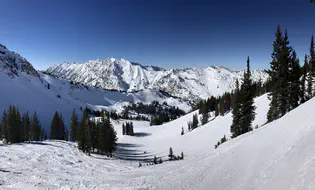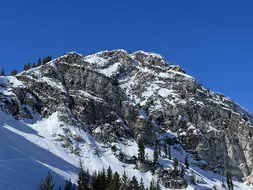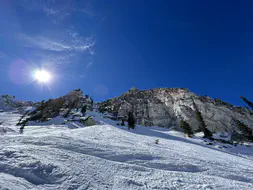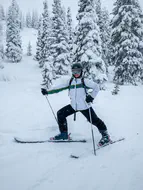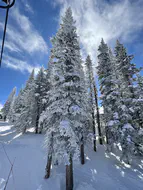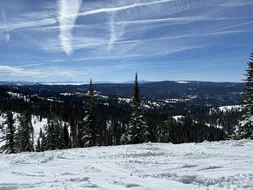Ikonic Tour 2022
Ski season on the road
Off we go for another ski season on the road…
January 31st - March 15th, 2022

Revelstoke
Revelstoke is a relatively new mountain, having only opened in 2007. Despite having a huge skiable area, there’s veritably only three lifts: the main gondola, Stoke chair, and Ripper chair. It usurped Whistler Blackcomb as the longest vertical descent of any ski resort in North America (5620 ft) which logically gave it the longest run in North America and the 4th longest in the world at 9.6 miles (The Last Spike). More than anything, it’s known for its powder and big mountain terrain, and the resort added Sno-Cat and Heliskiing tours.
Revelstoke is my ski heaven. We arrived at night, so the next morning we found ourselves in a valley, surrounded by towering mountains. There were scarcely any buildings in the town and each one was adorned with 2-3 feet of fresh powder, promising a magnificent day on the mountain. And so it was. The mountain was an absolute powder playland, and the smile couldn’t be torn from my face. It was a gigantic mountain, both vertically and area-wise, and it sure felt like it, especially with only one gondola and two lifts. Revelstoke presented itself as a proper mountain, with the peak not visible from the base, even when the sky was clear. We didn’t even realize at first that it had the largest vertical in North America but just kept getting absolutely exhausted by the end of the runs (really by the middle even).
The snow never truly stopped while we were there, with the peak going in and out of the clouds. It occasionally got a bit socked in with the snowfall at the top, which made it hard to see, but the new snow was worth it and provided a comfortable landing for any fall. Due to the sheer size of the mountain and the quantity of snow, it seemed the mountain could never truly be skied out. There were always pockets of powder everywhere you looked. I remember being at the top of the lift just thinking to myself “okay, which powder spot do I want to play in now.” There was countless glade runs (my favorite) and breathtaking views. Saturday was a bit rough in the morning since it was the day after a snowstorm (a perfect powder day), and the limited lifts presented significant bottlenecks. Luckily it cleared out pretty quickly around lunchtime, and the long powdery runs proved worth the wait. I absolutely cannot wait to go back and do heliskiing.
Vibe: pro freeskiers and backcountry nuts, people that go hard

videos coming soon
Red Mountain
Red mountain is in Rossland, a former Canadian gold mining town. It’s one of the oldest ski hills in North America, having opened in the first decade of the 1900’s and is actually Western Canada’s first alpine resort. Although generally geared towards intermediate and expert skiiers, it does have some easier terrain for the whole family. There’s 4 separate peaks – Red, Granite, Grey, and Kirkup – the latter of which is only accessible by cat skiing, which was unfortunately not open while we were there. Michel Trudeau, Justin Trudeau’s younger brother, worked there and was living in Rossland before he died during a backcountry skiing trip.
Red mountain was undeniably quaint. No other resort I’ve been to has felt quite like a “neighborhood mountain” such as this. There were very few people, even on the weekend, and everyone seemed to know each other. The parking lot attendant kept us company while we got ready, regaling us with his life story in a thick Canadian accent. The mountain had a place for everyone, with kids and their parents in matching costumes on the lower parts and expert old-man skiers and 20-something-year-old freeskiers jumping off rock ledges higher up. The lifts seemed barely newer than the resort, so those took quite some time to get up, and it certainly felt like a substantial portion of the day was spent on the lifts. We caught a bit of the Canadian open freeskiing competition which was unreal. Unfortunately, we got no new snow but plenty of sun, so it felt like spring skiing. That being said, by the time we were leaving, there were many bare patches. Some of the steeper double blacks couldn’t be skied because they were too exposed. I would absolutely like to visit again with fresh powder in a better snow year.
Vibe: local families and teenagers

Schweitzer
Schweitzer is settled in the northern Idaho panhandle, about 45 miles from the Canada - US border. Overlooking the beautiful Lake Pend Oreille (the 38th largest lake by area in the US), twilight skiing provides an unreal sunset. The resort just became a part of the Ikon pass this year, and is definitely up-and-coming. The mountain was named after an old Swiss ex-military hermit who lived at the bottom of the basin. Interestingly and disturbingly, a crime investigation involved the search of his house which uncovered the bodies of many local cats that had gone missing. Local legend said he enjoyed cat stew.
Schweitzer feels like it’s up-and-coming. If I had any money lying around, this is where I’d invest it. It’s still about 30 mins from any grocery store, but the town is being built up as we speak. Between the front and back sides of the mountain, it felt like there was plenty to do. There was some nice bowls and trees. It does feel like they do not know that it is actually an option to warn people about hazards on the trails (ie a caution sign before a rock drop off), but as long as you scope it out ahead of time, you’re pretty good to go. There is a nice beginner area at the bottom, which I always like because it sequesters them in one area. When we first got there, the snow was hard and we’d have to wait until later in the day once it softened up in the sun to really hit some runs and even then it was limited to where the sun had shown. Luckily by the last day, we got a few inches, which made for some unbelievable lines. Also, on the weekends, they have twilight skiing. The view overlooking the lake, especially during sunset, is a must see.
Vibe: locals with more and more out-of-towners on the way


Big Sky
Big Sky is the second largest resort in the US (after Park City) but is rugged in a way Park City is not. It lies mostly on the eastern face of Lone Mountain which can be accessed using the Lone Peak Tram. The tram, which accesses expert terrain, was once included in the daily lift tickets. While “lift tickets” generally include access to all the lifts at a resort, this year Big Sky decided to add a daily fee ranging from
What once was an extremely rugged mountain reserved for ski nuts with the advent of first ever US triple black diamonds is quickly becoming Vail-ified. For whatever reason, the resort has decided it wants to focus on boujie clientele with lift tickets priced at $235, limited and unaffordable lodging options nearby, and a loud and over-the-top apres scene. With their Big Sky 2025 plan, it’s just going to get worse. Lone Mountain, the beautiful and daunting top peak of Big Sky, is going to be converted to a much bigger tram that can be accessed from the bottom of the resort. Complaints about Lone Peak lines are about to look more ridiculous when the apres crowd can ride up from the bottom just to meander then ride down. Big Sky seems to want to be a Jackson Hole and Vail child, but Montana-sized. Unfortunately, there is still some of the best skiing here. There’s world-class versions of everything you could possibly want: park, steeps, trees. It’s one of the few US resorts with runs that require checkout with ski patrol.
Vibe: rich out-of-towners and pissed off locals
Jackson Hole
Jackson Hole Mountain Resort is located at Teton Village, Wyoming in the Teton Range of the Rocky Mountains, just south of Grand Teton National Park. It is known for its steep, challenging terrains and large vertical drop with only 10% beginner runs. It is continuously known in media as one of North America’s most expensive ski resorts and feels that way. Because of its location and proximity to the Grand Teton, it’s almost impossible to not see wildlife while in the area. More than anything else, Jackson Hole is known for the (in)famous Corbet’s Couloir, which has hosted a freeriding competition for the past 5 years - King and Queens of Corbet’s.
I dream about how rugged and untouched Jackson Hole was back in the day. I can’t even imagine being there in its heyday, incredible terrain with an undercurrent of cowboy spunk. Now it feels overdone and a tourist trap. The town really leans into the kitschy cowboy aspect, and the mountain is not big enough for the traffic it gets. Even though we were there outside of holiday season, it was entirely skied out (of course, no thanks to the lack of snowfall). The day after it dumped about a foot was a dream, but by the next day it was completely run through again. It was dealer’s choice between iced-out groomers and 8+ foot tall moguls. I love moguls as much as the rest, but at some height they desperately needed to get cut down. Jackson Hole will forever stand as a mecca for skiers, especially having contributed to freeriding and the fame of Corbet’s Couloir, but I do not necessarily need to go back. The area is beautiful though (it is the Grand Tetons of course), and I would love to give Grand Targhee a go as a less tracked alternative. While a lot of the town was cheap souvenirs, there were some beautiful western art galleries, and line dancing by the locals. Again, it was worth the trip once, and I’ll definitely be in the area again, even if it isn’t at Jackson Hole. That being said, it would be great to come back during a better snow year…
Vibe: wealthy families and some freeriding nuts
Alta
Alta lies in the wasatch mountains and is one of the oldest ski resorts in the US, with the first lift opening in 1939. Since 2002, it is connected to Snowbird either off of the Wildcat lift (double blacks) or off the backside through Snowbird’s Mineral Basin. The duo lie in Little Cottonwood Canyon, which has a particular microclimate that accumulates more snow than most other Utah resorts. Along with Deer Valley, Alta is one of the few remainined resorts that prohibits snowboarding while its counterpart (Snowbird) does not. Despite going to court for this, the ruling was maintained. It is known for its particularly challenging in-bounds ski area including long, straight, fall-line pitches. Future expansions include a tram to the top of Mt. Baldy, lifts from Sugar Bowl to Sugarloaf pass (currently a traverse), and better parking.
Alta and Snowbird are technically connected, but the vibe feels different, highlighted especially by the fact that Snowbird allows snowboarders (snowbirders?) while Alta devoutly does not. This does inevitably mean that Snowbird can get skied out (snowboarded out) quicker. Both have a variety of runs and difficulties because they are really part of the same mountain range. There’s everything you could possibly want – steeps, trees, etc. It’s the place to go if you want to ski hard. At the beginning of our time in SLC, the snow was miserable, so it almost wasn’t even worth wasting days here, but with the multiple powder dumps towards the end, this was the place to be. I ended up demoing powder skis here for a day that we got over a foot since lifts closed, and it was dumping the whole day, and I am obsessed. Absolutely one of the best ski days of the whole season.
Alta doesn’t allow snowboarders, and as a result there’s a bit of a chicken-egg situation with the vibe there. It is on average a much older crowd and can be a bit stuffier. That being said, there is some merit to it because it’s a lot easier for snowboarders (speaking as someone who snowboards as well) to clear new snow off a run with the I’m-not-good-enough-for-this-run sideways slide down the mountain. As such, powders sticks longer, and the runs don’t get as icy as quickly. If there’s no new snow, it’s difficult everywhere though because of the rocks. Everything off High Traverse is a great time with good snow as well as Wildcat. Supreme lift has good steeps up higher then some cruising glades lower down. Skiers that are regulars at Alta are some of the bests in the US. On a busy day, the lifts can get backed up, but I love Alta. It’s worth it.
Vibe: locals (typically old men) and families; some nutty younger skiers.
Snowbird
Snowbird opened in 1971 and sits next to Alta in Little Cottonwood Canyon in the Wasatch mountain range. Unlike Alta, it allows for both skiing and snowboarding. This canyon is considered the second snowiest ski areas in US after the cascades, but its dry and light rather than humid and wet making for significantly better skiing. Like Alta, it is known for its challenging terrain.
Snowbird does allow snowboarders, which brings in an entirely different crowd and attitude. The snowboarders and skiers are a lot younger and absolutely rip. Go to Little Cloud lift on a powder day, and you’ll see. It becomes a massive playground with people doing tricks I’ve only seen on TV just casually off any rock or mound they can find. The bottom parts can get skied out pretty quickly by beginners, but anything black diamond or above takes a while. Skier’s left has beautiful trees to get lost in for hours while skier’s right has good steeps. Without the drop in, hot foot gully is Snowbird’s response to Corbet’s. Mineral Basin, the back side, is a beautiful wide-open bowl but takes a lot more snow to fully cover than the front side or Alta. Overall, some of my favorite skiing. Pair it with Alta, and it’s an unbeatable combination.
Vibe: freeriding nutty locals and families
Brighton
Brighton, along with Solitude, is in the Wasatch Range of the Rockies in Big Cottonwood Canyon. It boasts a long history as the first ski resort in Utah and one of the first in the US, opening in 1936 with a rope tow. It’s considered a “no-frills” resort and acts as such, with standard parking, limited food options, and many brown bag lunch spots. Offering a single ride lift ticket option, Brighton also opens up to extensive backcountry access. Though it still counts as a full day, it is connected to Solitude via the SolBright run, which is relatively new and definitely not for beginners. Brighton offers a lot in the way of park riding from small to extra-large features, so a lot of pros got their start here. It is also one of the few resorts offering night skiing.
Brighton, in my opinion, has some of the best glades I’ve ever skied. They take over a significant portion of the mountain and range in difficulty – although there isn’t anything that will really kill you like some of the other resorts. On a powder day, you can just cruise trees here effortlessly and endlessly, soon finding yourself in a flow state. The night skiing is a great benefit (although it does count as a full day on the Ikon pass even if you only go at night). If you aren’t into park skiing then there’s not a lot of difficult runs once the sun sets because skiing trees becomes dark and dangerous. The resorts doesn’t have much in the way of steeps compared to Alta, Snowbird, or even its neighbor, Solitude. Luckily Solitude is (currently) unlimited days, so you can always split time if you want a bit more of a challenge. Everywhere you look at Brighton, there’s park rats who have likely been riding park since they could walk. There’s nothing quite as humbling as a 10-year-old ripping features that you would never even imagine doing.
Vibe: park rat locals
Deer Valley
Deer Valley, located in the Wasatch Range, built its first runs in 1936 and was host to the 2002 Winter Olympics. Often it is ranked the “top” ski resort in the US, primarily based on its amenities, including free ski valets and parking shuttles, fine dining options on the mountain, and boutique shopping. Even more so than the average ski resort, it caters to a more “upscale audience”. In that vein, they also prohibit snowboarders.
Do not get me wrong, deer valley has some great runs. The hike-to chutes are great with enough snow, plus there’s some good cruising glades. It’s also got a range of terrain for all levels. That being said, it is hands-down without a doubt, the boujiest ski resort I have ever been to (so far?). The amenities push for a certain clientele that is unmissable. If you are on the market for a ski bunny or a trust fund guy really into crypto, then this is your kind of place. The lines can get backed up, but on the plus side, they tend to die down almost immediately after lunch even on the busiest days and are concentrated to the lifts servicing greens and blues. It’s the kind of place that has bathrooms with heated floors, floor to ceiling wooden stall doors, and reusable hand towels to dry. At the same time, the stalls have no racks to put your gloves on and marble bathroom floors with no rugs, making walking in ski boots difficult. There is a certain clientele, and I don’t meet it. It’s a place to go on a bad snow day or if all your other days are used up…
Vibe: wealthy families, ski bunnies, crypto boys
Solitude
Solitude is also in Big Cottonwood Canyon in the Wasatch Mountain Range, neighboring Brighton. It is considered to be relatively family friendly, with a range of runs for all skill levels. Unlike Brighton, it is a more typical ski resort without much park riding. If anything, it is sort of a smaller version of Snowbird, with steeps and challenging upper limits for the runs. There is also extremely difficult sidecountry runs here available via hikes. It was first developed by uranium tycoon Robert M. Barrett, who decided to start his own ski resort after being denied the use of the restrooms at Alta, which were reserved for Alta guests only. In response, he bought all the land in Big Cottonwood Canyon, the next canyon of from Little Cottonwood Canyon, where Alta is.
Unlike some of the other resorts, Solitude still feels local and underappreciated. Because there’s less traffic than elsewhere and there’s good tree coverage, it holds the snow the best. At the beginning of our stay, we found ourselves going here often because there were still untouched tracks if you know where to look. It also remains as the only Utah resort with unlimited days, so it was a great place to get a couple laps in without worrying about burning a day. Solitude has a generally steeper pitch than Brighton resulting in steeper pitches and a higher ceiling for run difficulty.
Vibe: technically skilled locals
Steamboat
Steamboat Ski Area is located in Steamboat Springs on Mount Werner in the Park Mountain Range. It first opened in 1963 using the name “Storm Mountain Ski Area” but was changed only two years later after the mountain was renamed after local Olympian Buddy Werner. As of this year, the total number of winter Olympians with ties to Steamboat Springs is 100, making it the “Land of 100 Olympians”. The town has had representation in every winter Olympics since 1932, except for 1936, due to its rich history in ski jumping and both Nordic and downhill skiing. Howelsen Hill, located 10 minutes from Steamboat Ski Area, is the oldest continuously operating ski area in the US, operating since 1915. It has the largest and most complete natural ski jumping complex in North America and has been the training ground for 95 Olympians making over 165 Olympia appearances total. Steamboat Ski Area itself is home to Mavericks Superpipe, one of the few premier half-pipes in North America. Since 2013, Steamboat also has limited night skiing available.
Steamboat is an incredibly family-friendly ski area with a large range of terrain abilities. In my opinion, the only thing is lacks is very difficult steep terrain at the upper end of the skill level, which is pretty typical of many Colorado resorts. On the other hand, there’s some great cruising glades. The area gets a lot of snow, making it a great place to hang out and ski casually. Getting around the mountain can be a bit slow, especially if you’re trapped behind a family on the numerous catwalks. It can get really busy, so I would avoid going there during any “school” holidays if it can be avoided (ie winter or spring break). The local kids are impossible to miss because they will rip past you in packs with absolutely no fear.
Vibe: average out-of-town families and local nuts

